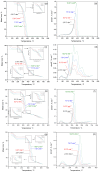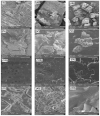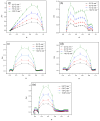Synthesis of β-Cyclodextrin-Functionalized Silver Nanoparticles and Their Application for Loading Cytisine and Its Phosphorus Derivative
- PMID: 40142112
- PMCID: PMC11944286
- DOI: 10.3390/molecules30061337
Synthesis of β-Cyclodextrin-Functionalized Silver Nanoparticles and Their Application for Loading Cytisine and Its Phosphorus Derivative
Abstract
In this study, the synthesis and properties of β-cyclodextrin-functionalized silver nanoparticles and their loading with a drug component are considered. β-Cyclodextrin was used as a reducing agent and stabilizer in the preparation of silver nanoparticles. The use of β-CD-AgNPs in loading molecules of the alkaloid cytisine (Cz) and its O,O-dimethyl-N-cytisinilphosphate (CzP) derivative, which have pronounced antiviral properties, was studied. The formation of β-CD-Cz-AgNPs and β-CD-CzP-AgNPs was confirmed by UV spectroscopy and X-ray diffraction spectroscopy. Scanning electron microscopy and transmission electron microscopy showed that the obtained β-CD-Cz-AgNP and β-CD-CzP-AgNP nanocomposites were well dispersed with particle sizes in the range of 3-20 nm. 1H-, 13C-NMR and COSY, HMQC, HMBC and Fourier transform infrared spectroscopy revealed the reduction and encapsulation of AgNPs by β-Cz, and the TEM imaging results showed an increase in the size of nanoparticles after the introduction of cytisine and its phosphorus derivative. The kinetic parameters of the thermal degradation process of β-CD, Cz, CzP and their inclusion complexes Cz(CzP)-β-CD-AgNPs under isothermal conditions, which ensure the preservation of the kinetic triplet, were determined. The differences in the mechanism of thermal decomposition of the studied materials are described by the parameters of the Šesták-Berggren model (m and n), which demonstrated differences for different compounds: for β-CD, the values of the parameters m and n are 0.47 and 0.53, respectively, while for CzP-β-CD-AgNPs they reach values of 0.66 and 1.34. These results indicate differences in the mechanism of thermal decomposition of the studied materials.
Keywords: antiviral activity; cytisine; encapsulation; inclusion complex; nanocomposites; silver nanoparticles; thermal decomposition; β-cyclodextrin.
Conflict of interest statement
The authors declare no conflicts of interest.
Figures



















Similar articles
-
Synthesis of cationic β-cyclodextrin functionalized silver nanoparticles and their drug-loading applications.RSC Adv. 2023 Mar 6;13(11):7250-7256. doi: 10.1039/d2ra08216k. eCollection 2023 Mar 1. RSC Adv. 2023. PMID: 36891497 Free PMC article.
-
Characterization, Antibacterial and Antioxidant Properties of Silver Nanoparticles Synthesized from Aqueous Extracts of Allium sativum, Zingiber officinale, and Capsicum frutescens.Pharmacogn Mag. 2017 Jul;13(Suppl 2):S201-S208. doi: 10.4103/pm.pm_430_16. Epub 2017 Jul 11. Pharmacogn Mag. 2017. PMID: 28808381 Free PMC article.
-
Effects of green synthesised silver nanoparticles (ST06-AgNPs) using curcumin derivative (ST06) on human cervical cancer cells (HeLa) in vitro and EAC tumor bearing mice models.Int J Nanomedicine. 2019 Jul 16;14:5257-5270. doi: 10.2147/IJN.S202404. eCollection 2019. Int J Nanomedicine. 2019. Retraction in: Int J Nanomedicine. 2022 Jul 12;17:3077-3078. doi: 10.2147/IJN.S381653. PMID: 31409988 Free PMC article. Retracted.
-
Supramolecular nanogels based on gelatin-cyclodextrin-stabilized silver nanocomposites with antibacterial and anticancer properties.J Biomater Sci Polym Ed. 2022 Apr;33(6):689-704. doi: 10.1080/09205063.2021.2009184. Epub 2022 Jan 20. J Biomater Sci Polym Ed. 2022. PMID: 35025724
-
Photocatalytic, antimicrobial activities of biogenic silver nanoparticles and electrochemical degradation of water soluble dyes at glassy carbon/silver modified past electrode using buffer solution.J Photochem Photobiol B. 2016 Mar;156:100-7. doi: 10.1016/j.jphotobiol.2016.01.016. Epub 2016 Feb 1. J Photochem Photobiol B. 2016. PMID: 26874611
Cited by
-
Synthesis and Properties of Silver Nanoparticles Functionalized with β-Cyclodextrin and Their Loading with Lupinine and Its Acetyl Derivatives.Molecules. 2025 Aug 12;30(16):3354. doi: 10.3390/molecules30163354. Molecules. 2025. PMID: 40871507 Free PMC article.
References
-
- Tsypysheva I.P., Koval’skaya A., Petrova P., Lobov A., Borisevich S.S., Tsypyshev D., Fedorova V.A. Diels-Alder adducts of N-substituted derivatives of (-)-Cytisine as influenza A/H1N1 Virus Inhibitors; Stereodifferentiation of antiviral Properties and Preliminary Assessment of Action Mechanism. Tetrahedron. 2019;75:2933–2943. doi: 10.1016/j.tet.2019.04.021. - DOI
-
- Fedorova V.A., Kadyrova R.A., Slita A.V., Muryleva A.A., Petrova P.R. Antiviral activity of amides and carboxamides of quinolizidine alkaloid (−)-cytisine against human influenza virus A(H1N1) and parainfluenza virus type 3. Nat. Prod. Res. 2019;35:4256–4264. doi: 10.1080/14786419.2019.1696791. - DOI - PubMed
Grants and funding
LinkOut - more resources
Full Text Sources

